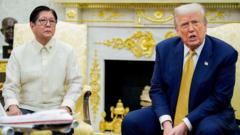Will Philippines Goods Face a 19% Tariff Under Trump?

Understanding the Impact of US Tariffs on Imports from the Philippines
The recent announcement of a 19% tax on imports from the Philippines by the US administration has stirred significant discussion among economists, trade analysts, and business leaders. This decision, articulated by President Donald Trump after a meeting with the Philippine president, is part of a broader trade agreement that includes mutual tariff reductions and military cooperation. While the details of the agreement remain sparse, the implications of such a tariff could resonate throughout various sectors in both countries, affecting everything from consumer prices to international relations.
The Context of the Tariff Announcement
President Trump has been vocal about his strategy to impose tariffs as a means to rectify trade imbalances that he perceives as unfair to the United States. This move follows a series of trade negotiations with multiple countries, aiming to establish what his administration calls “fair trade.” However, the imposition of tariffs has historically led to retaliatory measures, creating a complex web of trade relations that can affect global markets.
The Details of the New Tariff
The newly announced tariff rate of 19% on imports from the Philippines is a significant increase compared to earlier threats of 17% and even 20%. This new rate indicates a firm stance by the US administration amid ongoing negotiations. The Philippines, which exported approximately $14.2 billion worth of goods to the US last year, will feel the weight of this tariff, especially in sectors like automotive parts, electric machinery, textiles, and coconut oil.
Potential Economic Consequences
The economic ramifications of such tariffs can be profound. Here are some of the potential effects:
- Increased Consumer Prices: Tariffs typically lead to higher prices for imported goods. For consumers in the US, this could mean paying more for everyday items that rely on imports from the Philippines.
- Impact on American Businesses: Companies that rely on Philippine imports for production may face increased costs, impacting their profitability. General Motors recently reported losses exceeding $1 billion due to tariffs.
- Retaliation from the Philippines: The Philippines may respond with tariffs of their own, leading to a tit-for-tat scenario that could escalate tensions and further complicate trade relations.
- Effect on Employment: Industries heavily reliant on Philippine imports may face downsizing or cutbacks due to increased operational costs, affecting jobs in these sectors.
Broader Trade Implications
The announcement has implications beyond just the US and the Philippines. With Trump threatening new tariffs on multiple fronts, including the European Union and Canada, the global trading landscape may be entering a period of increased uncertainty. Countries that feel threatened by US tariffs may band together to form coalitions against what they view as protectionist policies, potentially leading to a global trade war.
Historical Context of US Tariff Policies
Tariffs have been a cornerstone of American trade policy for centuries, with fluctuating rates reflecting the changing priorities of different administrations. The current tariff environment is reminiscent of the early 1900s when the US enacted some of its highest duties. Trump’s tariffs mark a return to these protective measures, aimed at shielding American industries from foreign competition. However, history shows that excessive tariffs can lead to long-term economic challenges, including decreased competitiveness for domestic companies.
Trade Negotiations and Their Challenges
The ongoing trade negotiations are complex and fraught with challenges. President Trump's approach has been to leverage tariffs as a negotiating tool, but this strategy can backfire. The insistence on maintaining high tariffs can hinder progress in negotiations, as countries may be unwilling to compromise when faced with punitive measures. The situation is further complicated by changing geopolitical dynamics and domestic pressures within the countries involved.
Potential Reactions from the Philippines
While the Philippines has not yet confirmed the details of the trade agreement, the government’s response will be crucial. Trade officials may seek to negotiate terms that minimize the impact of the tariffs on their economy. They might also explore alternative markets to mitigate the potential losses from reduced exports to the US.
The Role of the Global Economy
The interconnected nature of the global economy means that changes in trade policies in one country can have ripple effects worldwide. The Philippines, while a smaller trading partner for the US, plays a crucial role in certain supply chains. A sudden increase in tariffs could disrupt these chains, affecting businesses and consumers far beyond the borders of these two nations.
Future Outlook and Considerations
As the situation develops, stakeholders across various sectors must remain vigilant. Here are some key considerations for the future:
- Monitoring Trade Developments: Businesses should keep a close eye on trade negotiations and be prepared to adapt to changes in tariffs and trade policies.
- Diversifying Supply Chains: Companies may want to consider diversifying their supply chains to mitigate risks associated with tariffs and trade tensions.
- Engaging in Dialogue: Open communication between governments and businesses can facilitate better understanding and potentially lead to more favorable trade agreements.
FAQs
What goods are primarily affected by the new tariff on imports from the Philippines?
The new tariff primarily affects goods such as car parts, electric machinery, textiles, and coconut oil, which are significant exports from the Philippines to the US.
How does this tariff impact US consumers?
The tariff is likely to result in higher prices for imported goods, which can affect consumer spending and overall economic health.
Are there any expected retaliatory measures from the Philippines?
While the Philippines has not confirmed any retaliatory measures, it is a possibility that they may impose their own tariffs on US goods in response to the new 19% tariff.
What are the long-term implications of such tariffs on global trade?
The long-term implications could include strained trade relationships, potential trade wars, and disruptions in global supply chains, leading to economic uncertainty.
In conclusion, the announcement of a 19% tariff on imports from the Philippines by the US raises significant concerns regarding economic stability, international relations, and the future of trade agreements. As nations navigate these changes, the interconnectedness of global markets will play a crucial role in determining the outcomes of these policies. How will businesses adapt to these new challenges, and what strategies will they implement to sustain their operations?
#Trade #Tariffs #GlobalEconomy
```Published: 2025-07-22 23:40:08 | Category: technology



